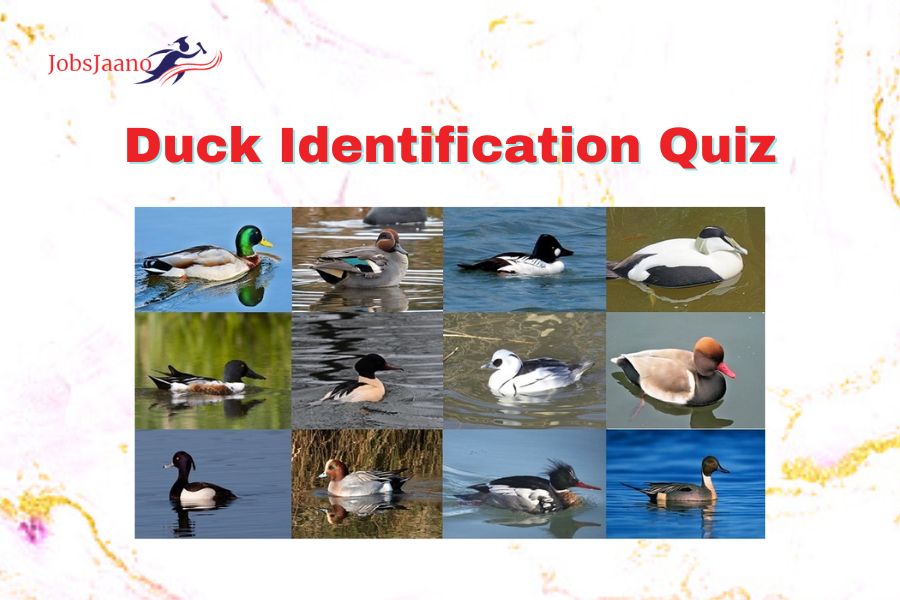Duck ID Quiz | Duck Identification Quiz
-
Which species’ drake puffs up its cheeks and neck and mews like a cat during courtship?
(a) Ruddy duck
(b) Redhead
(c) American wigeon
Ans. a
-
Which duck dives the deepest in search of food?
Which of these ducks dives deepest for food?
(a) Canvasback
(b) Long-tailed duck
(c) Harlequin duck
(d) American wigeon
Ans. b
-
The eyes color of the Barrow’s goldeneye can be used to distinguish it from the common goldeneye.
(a) Yes
(b) No
Ans. b
-
Which species of diving duck is the smallest in North America?
(a) Bufflehead
(b) Ring-necked duck (Incorrect)
(c) Ruddy duck
(d) Canvasback
Ans. a
-
Which type of diving duck has the best maneuverability?
(a) Redhead
(b) Ring-necked duck
(c) Ruddy duck
(d) Canvasback
Ans. b
-
There are only common goldeneyes in North America.
(a) Yes
(b) No
Ans. b
-
How soon can diving ducklings dive underwater after hatching?
(a) Within two days
(b) Within a week
(c) Immediately (Incorrect)
(d) Within one day
Ans. a
-
Northern Europe, North America, and Asia are all home to both lesser and greater scaup.
(a) Yes
(b) No
Ans. b
-
Which species of duck nearly exclusively builds its nest in the holes made by northern flickers?
(a) Bufflehead
(b) Hooded merganser
(c) Ruddy duck
(d) Wood duck
Ans. a
-
Which of these ducks parasitizes canvasback hen nests frequently enough to affect the viability of reproduction?
(a) Lesser scaup
(b) Ring-necked duck
(c) Redhead
(d) Hooded merganser
Ans. c
-
Compared to other ducks, the petite ruddy duck lays tiny eggs.
(a) False
(b) True
Ans. a
-
Depending upon the species and favored food sources, waterfowl bills come in a variety of sizes and shapes. The unique broad bill of the northern shoveler is made for:
(a) Catching fish
(b) Pulling up aquatic vegetation
(c) Straining plankton in the water column
(d) Grabbing acorns
Ans. c
-
The temperature is around 80 degrees and it is the beginning of the teal season. What kind of habitat are these tiny puddle ducks most likely to inhabit?
(a) flowing stream
(b) dry cornfield
(c) deep lake
(d) shallow marsh filled with aquatic life
Ans. d
-
Which of these retriever breeds has the greatest popularity in North America?
(a) Labrador retriever
(b) Golden retriever
(c) Standard poodle
(d) Chesapeake Bay retriever
Ans. a
-
Which of these puddle duck species would be best suited for calling using a duck whistle?
(a) Northern shoveler
(b) Black duck
(c) Pintail
(d) Gadwall
Ans. c
-
Which of the following species has the moniker “poacher duck”?
(a) Mottled duck
(b) Pintail
(c) American wigeon
(d) Black duck (Incorrect)
Ans. c
-
A duck call should be thrown away and replaced as soon as it begins to sound terrible.
(a) False
(b) True
Ans. a
-
Where do wood duck breeding densities for the species peak?
(a) Central Canadian Artic (Incorrect)
(b) Northern prairies of central North America
(c) Mississippi Alluvial Valley
(d) The northern Hudson Bay shoreline
Ans. c
-
Prior to 1918, wood ducks were one of the most hunted species of waterfowl. What was the name of the statute that made it illegal to shoot wood ducks across the country?
(a) The Lacey Act
(b) The Federal Migratory Bird Law
(c) Migratory Bird Treaty Act
(d) The Airborne Hunting Act (Incorrect)
Ans. c
-
In what year was the wood duck hunting season reinstated after the population started to recover?
(a) 1941
(b) 1925
(c) 1937
(d) 1952
Ans. a
-
What is another popular name for a wood duck?
(a) California Duck
(b) Carolina Duck
(c) American wigeon
(d) Colorado Duck
Ans. b
-
What is the maximum flight speed of a wood duck?
(a) 30 miles per hour
(b) 40 miles per hour
(c) 25 miles per hour
(d) 20 miles per hour
Ans. a
-
Wood duck females frequently use their own breast feathers to line their nests.
(a) False
(b) True
Ans. b
-
Only one duck in North America that consistently raises two broods a year is the wood duck.
(a) False
(b) True
Ans. b
-
How many eggs on average can a female wood duck lay in a clutch?
(a) 8
(b) 4
(c) 18
(d) 12
Ans. d
-
How long is the typical incubation period for wood ducks, depending on population and dispersion ranges?
(a) 15 days
(b) 30 days
(c) 14 days
(d) 45 days
Ans. b
-
The smallest of the dabbling ducks is the wood duck.
(a) False
(b) True
Ans. a

